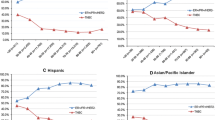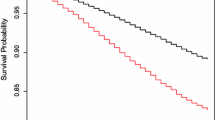Abstract
Objective
The primary objective of this study was to evaluate the race-specific risk associated with HER2/neu positive breast carcinoma in a prospective cohort design. Our secondary objectives were to assess prevalence of different breast cancer phenotypes between African-American and White women and to determine if race was associated with the risk of basal-like breast carcinoma phenotype in this cohort.
Methods
Demographic, clinical and pathologic data were collected from existing databases. The status of HER2/neu and hormone receptors was dichotomized as either positive or negative. Immunohistochemistry taxonomy was used to assess prevalence of different breast carcinoma phenotypes. Risk estimates were calculated using the multivariable logistic regression statistics.
Conclusions
The risk of HER2/neu positive breast carcinoma differs between African-American and White women. For White women only, this risk was statistically significant and increased almost linearly within each TNM stage with grade dedifferentiation. The statistically significantly higher prevalence of “ER−/PR−, HER2− ” phenotype in African American women potentially is the attributing factor to observed lack of an association between the risk of HER2/neu positive breast carcinoma with advanced stages and poorly differentiated grade. Among women diagnosed with “ER−/PR−, HER2−” phenotype the odds ratios of being African-American and pre-menopausal was 1.72 (95% CI 1.17–2.54, P = 0.006) and 1.94 (95% CI 1.27–2.96, P = 0.002), respectively. The histologic features of basal-like and ER−/HER2+ carcinomas overlaps. Differences in the biology of breast carcinoma between African American and White women are partially attributed to the disparity in more adverse pathologic prognostic indicators at the initial clinical presentation of this disease.
Similar content being viewed by others
References
Dignam JJ (2000) Differences in breast cancer prognosis among African American and Caucasian women. CA-Cancer J Clin 50:50–64
Jones LA, Brawley O, Johnoson-Thompson M et al (2003) Overview of the summit meeting evaluating research in African-American women. Cancer 97:207–210
Newman LA, Mason J, Cote D et al (2002) African-American ethnicity, socioeconomic status, and breast cancer survival. A meta-analysis of 14 studies involving over 10,000 African-American and 40,000 White American patients with carcinoma of the breast. Cancer 94:2844–2854
Sorlie T, Perou CM, Tibshirania R, Aas T, Geiser S, Johnson H et al (2001) Gene expression patterns of breast carcinomas distinguish tumor subclasses with clinical implications. PNAS 98:10869–10874
Perou C, Sorlie T, Eisent MB, van de Rijn M, Jeffrey S, Rees CA et al (2000) Molecular portraits of human breast tumors. Nature 406:747–752
Sorlie T, Tibshirani R, Parker J, Hastie T, Marron JS, Nobel A et al (2003) Repeated observation of breast tumor subtypes in independent gene expression data sets. PNAS 100:8418–8423
Carey LA, Perou CM, Livasy CA, Dressler LG, Cowan D, Conway K et al (2006) Race, breast cancer subtypes, and survival in the carolina breast cancer study. JAMA 295:2492–2502
Wang S, Saboorian MH, Frenkel E, Hynan L, Gokaslan ST, Ashfaq R (2000) Laboratory assessment of the status of HER-2/neu protein and oncogen in breast cancer: comparison of immunohistochemistry assay with flurescence in situ hybridization assay. J Clin Pathol 53:374–381
Nielsen TO, Hsu FD, Jensen K, Cheang M, Karaca G, Hu Z et al (2004) Immunohistochemical and clinical characterization of the basal like subtype of invasive breast carcinoma. Clin Cancer Res 10:5367–5374
Livasy CA, Karaca G, Nanda R, Tretiakova MS, Olopade OI, Moore DT et al (2006) Phenotypic evaluation of the basal-like subtype of invasive breast carcinoma. Mod Pathol 19:264–271
Fisher ER, Adnerson S, Dean S, Dabbs D, Fisher B, Siderits R et al (2004) Solving the dilemma of the immunohistochemical and other methods used for scoring estrogen receptor and progesterone receptor in patients with invasive breast carcinoma. Cancer 103:164–173
Linden M Assessment of estrogen receptor, progesterone receptors by biochemical ligand-binding assays immunohistochemistry technique; a validation study. Unpublished data
Allred DC, Harvey JM, Berardo M, Clark GM (1998) Prognostic and predictive factors in breast cancer by immunohistochemical analysis. Mod Pathol 11:155–168
Hosmer D, Lemeshow S (1997) Applied logistic regression, 2nd edn. John Wiley & Sons, New York (NY)
Wojcik BE, Spinks MK, Optenberg SA (1998) Breast Carcinoma survival analysis for African-American and White women in an equal-access healthcare system. Cancer 82:1310–1318
Jatoi I, Becher H, Leake CR (2003) Widening disparity in survival between White and African-American Patients with breast carcinoma treated in the U.S. department of defense healthcare system. Cancer 98:894–899
Shaver VL, Brown ML (2002) Racial and ethnic disparities in the receipt of cancer treatment. J Natl Cancer Inst 94:334–357
Boyer-Chammard A, Taylor TH, Anton-Culver H (1999) Survival differences in breast cancer among racial/ethnic groups: a population-based study. Cancer Detect Prev 23:463–473
Gapstur SM, Dupuis J, Gann P, Collila S, Winchester DP (1996) Hormone receptor status of breast tumors in Black, Hispanic, and non-Hispanic women. An analysis of 13,239 cases. Cancer 77:1465–1471
Beverly LN, Flanders WD, Go RCP, Soong SJ (1987) A comparison of estrogen and progesterone receptors in Black and White breast cancer patients. Am J Public Health 77:351–353
Elledge RM, Clark GM, Chamness GC, Osborne CK (1994) Tumor biologic factors and breast cancer prognostic among White, Hispanic, and Black women in the United States. J Natl Cancer Inst. 86:705–712
Wu Y, Khan H, Chillar R, Vadgama JV (1999) Prognostic value of plasma HER-2/neu in African-American and Hispanic women with breast cancer. Int J of Oncol 14:1021–1035
Jones C, Nonni AV, Fulford L, Merret S, Chaggar R, Eusebi V et al (2001) CGH analysis of ductal carcinoma of the breast with basaloid/myoepithelial cell differentiation. British J Cancer 85:422–427
Tsuda H, Takarabe T, Teruko CT, Hasegawa F, Fumio MT, Fukutomi T et al (2000) Large, central acellular zones indicating myoepithelial tumor differentiation in high-grade invasive ductal carcinomas as markers of predisposition to lung and brain metastases. Am J Surg Pathol 24:197–202
van de Rijn M, Perou CM, Tibshirani R, Haas P, Kallioniemi O, Kononen J et al (2002) Expression of cytokeratin 17 and 5 identifies a group of breast carcinomas with poor clincial outcome. Am J Pathol 161:1991–1996
Abd El-Rehim DM, Pinder SE, Paish CE, Bell J, Blamey RW, Robertson JFR et al (2004) Expression of luminal and basal cytokeratims in human breast carcinoma. J Pathol 203:661–671
Tsuda H, Takarabe T, Hasegawa T, Murata T, Hirohashi S. (1999) Myoepithelial differentiation in high-grade invasive ductal carcinoma with large central acellular zones. Hum Pathol 10:134–139
Newman LA, Bunner S, Carolin K, Bouwman D, Kosir MA, White M et al (2002) Ethnicity related differences in the survival of young breast carcinoma patients. Cancer 95:21–27
Foulkes WD, Stefansson IM, Chappuis PO, Begin LR, Goffin JR, Wong N et al (2003) Germline BRCA1 mutations and a basal epithelial phenotype in breast cancer. J Natl Cancer Inst 95:1482–1485
Siziopikou KP, Ariga R, Proussaloglou KE, Gattuso P, Cobleigh M (2006) The challenging estrogen receptor-negative/progesterone receptor-negative/HER-2 negative patient: A promising candidate for epidermal growth factor receptor-targeted therapy? The Breast J 12:360–362
Author information
Authors and Affiliations
Corresponding author
Rights and permissions
About this article
Cite this article
Stark, A., Kapke, A., Schultz, D. et al. Advanced stages and poorly differentiated grade are associated with an increased risk of HER2/neu positive breast carcinoma only in White women: findings from a prospective cohort study of African-American and White-American women. Breast Cancer Res Treat 107, 405–414 (2008). https://doi.org/10.1007/s10549-007-9560-5
Received:
Accepted:
Published:
Issue Date:
DOI: https://doi.org/10.1007/s10549-007-9560-5




